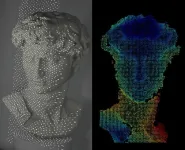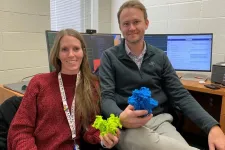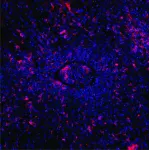(Press-News.org)
Huntsman Cancer Institute at the University of Utah (the U) proudly introduces the first and only single-port robot in the Mountain West for head and neck surgical oncology patients. This state-of-the-art technology is a groundbreaking step in the field of oncological surgery, allowing for greater precision and less invasive procedures. Under the visionary leadership of dedicated healthcare professionals, the institute is committed to revolutionizing treatments for cancer patients.
“I am delighted that Huntsman Cancer Institute can now offer cancer patients in the Mountain West access to this innovative and life-changing technology,” says Sachin Apte, MD, MS, MBA, chief clinical officer at Huntsman Cancer Institute, physician-in-chief of the cancer hospital, and professor of obstetrics and gynecology at the U. “While our surgeons have been conducting robotic cancer surgery for over a decade, the single-port robot represents a significant advancement that can substantially improve recovery time and minimize side-effects in select patients.”
The first person to have this procedure in the Mountain West will be 34-year-old Salt Lake City resident Reyes Salazar. The new robot will remove a non-cancerous cyst from the back of his throat. Doctors discovered a cyst near his airway when he was eight and despite successful laser removal, the cyst has reemerged. “If it were to roll over and block my air passage, I could suffocate in my sleep without even knowing,” remarks Salazar. “So, I prefer not to really take it lightly.”
Hilary McCrary, MD, MPH, head and neck surgical oncologist and microvascular reconstruction surgeon at Huntsman Cancer Institute and assistant professor of otolaryngology at the U, will be conducting the surgery. She first learned robotic surgery during residency, and received comprehensive training in the full spectrum of head and neck cancer care during her fellowship at Ohio State University.
“After all these years, my body has been through enough trauma from past operations,” Salazar says. “I can finally give my body the peace of mind and rest that it needs." Despite his nerves about the upcoming procedure, Salazar remains overwhelmingly optimistic and holds high hopes for success, not only for himself but for others in similar situations.
Before the Food and Drug Administration (FDA) granted approval for the utilization of robots in head and neck surgeries, procedures that allowed access to the back of the throat required surgeons to split the mandible, or lower jawbone, to access areas that were otherwise inaccessible. McCrary envisions a bright, promising future for robotic surgery and believes that this technological leap forward will expand possibilities and increase the number of patients eligible for treatment.
The single-port robot is equipped with novel instrumentation and technology tailored to perform effectively within a narrow field. It incorporates a state-of-the-art camera with the capability to change shape, providing increased visibility around corners, which proves valuable when dealing with tumors in the base of the tongue or supraglottic region. This advanced method is becoming the national standard of care among head and neck practitioners, offering patients the potential for faster recovery, reduced scarring, and improved outcomes.
Huntsman Cancer Institute first opened its robotic surgery program in 2011 and remains one of the most advanced and comprehensive in the U.S. today. With 15 surgeons performing in a variety of specialized cancer procedures, they have completed over 5,000 robotic operations to date.
While head and neck cancers may develop for a variety reasons, the American Cancer Society (ACS) states that the human papillomavirus (HPV), makes up for most cancers found in the back of the throat and can be linked to other cancer types. Individuals are strongly encouraged to consider receiving the HPV vaccine as a preventative measure.
About Huntsman Cancer Institute at the University of Utah
Huntsman Cancer Institute at the University of Utah (the U) is the National Cancer Institute-designated Comprehensive Cancer Center for Utah, Idaho, Montana, Nevada, and Wyoming. With a legacy of innovative cancer research, groundbreaking discoveries, and world-class patient care, we are transforming the way cancer is understood, prevented, diagnosed, treated, and survived. Huntsman Cancer Institute focuses on delivering a cancer-free frontier to all communities in the area we serve. We have more than 300 open clinical trials and 250 research teams studying cancer at any given time. More genes for inherited cancers have been discovered at Huntsman Cancer Institute than at any other cancer center. Our scientists are world-renowned for understanding how cancer begins and using that knowledge to develop innovative approaches to treat each patient’s unique disease. Huntsman Cancer Institute was founded by Jon M. and Karen Huntsman.
END
Forty-three million Americans lack access to municipal water, and 1 in 10 people globally do not have access to safe drinking water. Rice University’s new WaTER Institute, launched today, aims to address this and other complex water-related challenges.
“Clean water can save more lives than doctors,” said Pedro J. Alvarez , the institute’s director and the George R. Brown Professor of Civil and Environmental Engineering.
The institute’s researchers will also predict and prevent diseases by monitoring wastewater; ...
(February 2, 2024) The National Association of Epilepsy Centers (NAEC) has developed updated guidelines that outline the comprehensive services and resources epilepsy centers should provide to improve quality of care for people whose epilepsy is not well-controlled.
An Executive Summary of the 2023 Guidelines for Specialized Epilepsy Centers: Report of the National Association of Epilepsy Centers Guideline Panel was published online on February 2, 2024, in Neurology®, the medical journal of the American Academy of Neurology. The complete NAEC guidelines are published as an eAppendix on the journal’s website.
Epilepsy is one of the most ...
With a $300,000 grant, the Welch Foundation is supporting University of Texas at Arlington research into why some types of Mycobacterium tuberculosis (Mtb), the bacteria that causes the lung disease tuberculosis (TB), do not respond to treatments.
Since its founding in 1954, the Houston-based Welch Foundation has contributed to the advancement of chemistry through research grants, departmental programs, endowed chairs and other special projects in Texas.
“As one of the nation’s largest private funding sources for chemical research, it is our job ...
Many people are familiar with facial recognition systems that unlock smartphones and game systems or allow access to our bank accounts online. But the current technology can require boxy projectors and lenses. Now, researchers report in ACS’ Nano Letters a sleeker 3D surface imaging system with flatter, simplified optics. In proof-of-concept demonstrations, the new system recognized the face of Michelangelo’s David just as well as an existing smartphone system.
3D surface imaging is a common tool used in smartphone facial recognition, as well as in computer vision and autonomous driving. These systems typically consist of a dot projector that contains multiple components: ...
Many complex systems, from microbial communities to mussel beds to drylands, display striking self-organized clusters. According to theoretical models, these groupings play an important role in how an ecosystem works and its ability to respond to environmental changes. A new paper in PNAS focused on the spatial patterns found in drylands offers important empirical evidence validating the models.
Drylands make up 40 percent of the Earth’s landmass and are places where water is the limiting resource for life. They often display a characteristic ...
DURHAM, N.C. – As the HIV virus glides up outside a human cell to dock and possibly inject its deadly cargo of genetic code, there’s a spectacularly brief moment in which a tiny piece of its surface snaps open to begin the process of infection.
Seeing that structure snap open and shut in mere millionths of a second is giving Duke Human Vaccine Institute (DHVI) investigators a new handle on the surface of the virus that could lead to broadly neutralizing antibodies for an AIDS vaccine. Their findings appear Feb. 2 in Science Advances.
Being able to attach an antibody specifically to ...
Some hereditary genetic defects cause an exaggerated immune response that can be fatal. Using the CRISPR-Cas9 gene-editing tool, such defects can be corrected, thus normalizing the immune response, as researchers led by Klaus Rajewsky from the Max Delbrück Center now report in “Science Immunology.”
Familial hemophagocytic lymphohistiocytosis (FHL) is a rare disease of the immune system that usually occurs in infants and young children under the age of 18 months. The condition is severe and has a high mortality rate. It is caused by various gene mutations that prevent cytotoxic T cells from functioning normally. These ...
BIRMINGHAM, Ala. – Cigarette smoke exposure is associated with the development and severity of chronic obstructive pulmonary disease, or COPD, which is the third leading cause of death worldwide.
Cigarette smoke contains 2 to 3 micrograms of cadmium, a highly toxic metal and environmental pollutant, per cigarette. Burning tobacco releases cadmium oxide that can be adsorbed onto microparticles in smoke that travel deep into the lungs. Furthermore, the body is not able to remove cadmium, which accumulates in longtime smokers.
In ...
First-of-its-kind research on cryptocurrency finds that the most regulated coins create the most efficient markets.
That crypto regulation, often provided by cryptocurrency exchanges like Binance, can also help protect investors by providing reliable, public information.
“Both small and institutional investors should know, if they invest in coins without any regulation, they may suffer from price manipulation or a severe lack of insider information,” said Liangfei Qiu, a University of Florida professor of business and one of the authors of the new study.
“Instead, they may want to invest in coins listed with platforms ...
The ancient astronomer Nicolaus Copernicus was the first scientist to document the theory that the sun is the center of the universe in his book, De Revolutionibus Orbium Coelestium (On the Revolutions of the Heavenly Spheres). That first edition book, along with a delicate manuscript from astronomer Johannes de Sacrobosco, that is contrary to Copernicus’ groundbreaking theory, has now found a permanent home at Rochester Institute of Technology.
The texts were donated to RIT’s Cary Graphic Arts Collection, one of the world’s premier libraries on graphic communication history and practices. The donor is Irene ...






